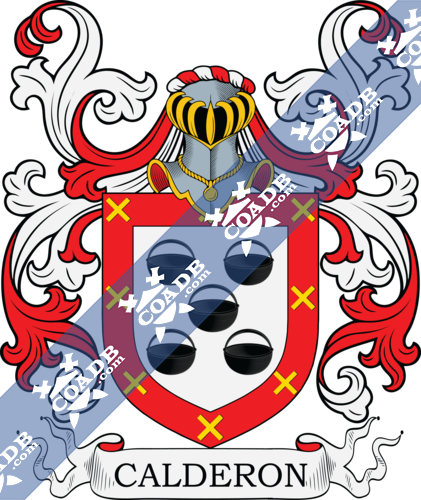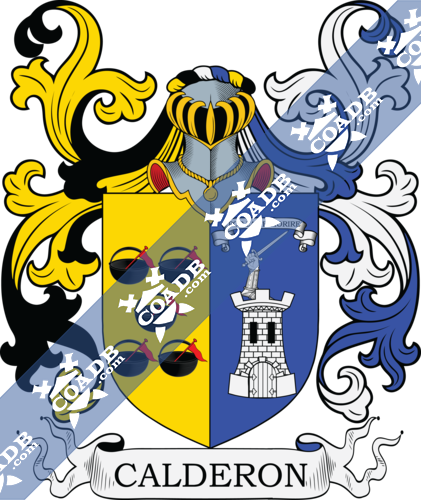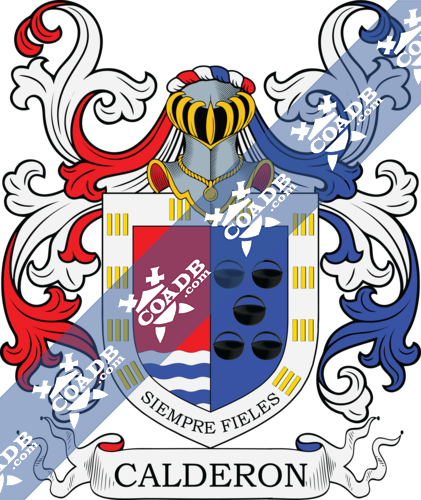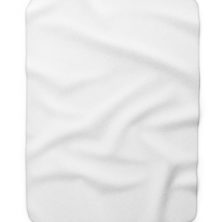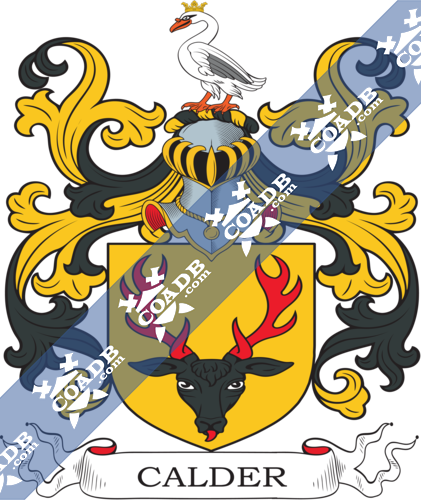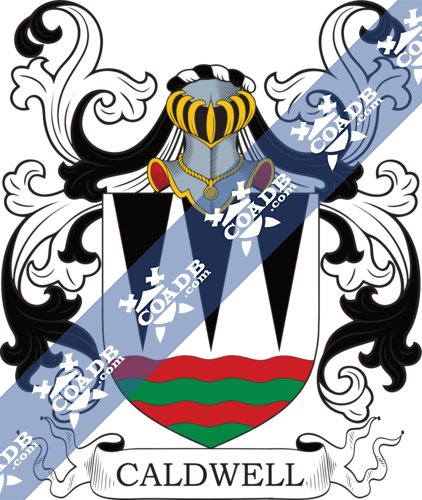Calderon Family Crest, Coat of Arms and Name History

Calderon Coat of Arms Gallery
Don’t know which Coat of Arms is yours?
We can do a genealogical research. Find out the exact history of your family!
Learn MoreSurname Meaning, Origin, and Etymology
Many surnames were created during the middle age in Europe, most of them were derived from the name of the father or the place of origin of the bearer. However, this was not the case for all the last names, there was another category, the occupational surnames, that were based on the job of its user. This kind of surnames was established after the jobs became hereditary and they began to be passed from the father to son.
One of the most popular occupational surnames was Calderon, which although it became very popular during the medieval period, its etymological origin can be traced further back to the Roman Empire because it is derived from the word “caldarium”. This surname was assigned to someone who worked on the creation of cooking vessels, pots, and boilers, mainly those that were very big and were hung up over a fire to cook meals like stews and soups. Calderon could also be used by the person who sold this cooking implements.
This surname was present in several countries of Europe, actually, it has at least one variation in some languages such as Cowdron in English and Codron in French, but it was mostly present in Spain and England. The first bearer of Calderon in Spain was Fortún Ortiz Calderón who was mentioned by King Alfonso X of Castile in his document “Heredamientos de Sevilla” circa 1200 and the first bearer in England was Stephen Caldron, who appeared in a record of Yorkshire in 1289. Calderon arrived in England during the Norman Conquest in 1066.
Spelling Variations
It was very common that a European Medieval surname counts on many spelling variations thanks to typical reasons of that time. Several cultures were mixing because of all the wars that occurred during that period and with a lot of new surnames were born thanks to that mix. Many words and surnames were translated incorrectly and there was also the fact that the scribes wrote words according to their sound, and if each scribe heard the words differently then, they wrote them in different ways.
In the particular case of Calderon, there were spelling variations on Spanish and English, thanks to its origin. The Spanish ones were Calderon, Calderón, Caldero and Caldera, and the English ones were: Calderon, Calderone, Cauldron, Cawdron, Coldron and Caldron.
Popularity & Geographic Distribution
According to the census of 2014, Calderon is the 670th most common surname in the world with approximately 780,134 bearers. The country with the biggest amount of bearers of Calderon is Mexico, followed by Colombia on the second place and Peru on number four. It has its highest density in Costa Rica.
Early Bearers of the Surname
Some of the old bearers of Calderon were Juan Boya Caldero at Vizcaya, Spain on August 30, 1573, Manuel Calderon of Los Angeles, California on June 1, 1850, Rodrigo Calderón, maybe the most famous user of this surname, who was an important nobleman and politician of Spain in the seventeenth century, Juan Calderón de la Parka a nobleman and court officer of Spain in the seventeenth century, and Pedro Calderón de la Barca, a Spanish poet and dramatist from the seventeenth century.
History, Genealogy, and Ancestry
A Calderon family with a good record of its genealogical tree is the one of Gaspar Calderón, who got married to Mariana Benítez, both of them were from Extremadura, Spain. They had a daughter called Mariana Calderón Benítez who was born in Extremadura and got married to Francisco de Urbina, son of Juan Ortiz de Urbina and María Fernández de Cacho y Doipa. Their son was Gaspar Calderón Urbina who was born in Mendoza, Argentina and in 1600 got married to María Antonia Durán de la Vega, daughter of Tomás Veas Durán and Antonia de la Vega.
Gaspar and María Antonia had a son named Tomás Calderón y Durán, who was born in Santiago de Chile. Tomás occupied several charges in his local government and got married to Ana de la Torre y Machado de Chavéz, daughter of Pedro de la Torre and Isabel Machado de Chávez, who was born in 1632. They had eleven children, they were Juan Calderón de la Torre who was born in Santiago and got married to Bartolina Girón de Montenegro y Santibáñez, María Calderón de la Torre who got married to Antonio de Carvajal y Bravo de Saravia, Gaspar Calderón y de la Torre Chávez who got married to Constanza Chacón y Cajal for the first time and to Ana María Agueda de Covarrubias y Lisperguer for the second time. From this marriage would be born Maria Josefa Calderón y Covarrubias Lisperguer.
The fourth child of Tomás Calderón y Durán and Ana de la Torre y Machado de Chávez was Pedro Calderón y de la Torre Chávez who got married to María de la Barrera y Ortiz de Elguea. The fifht child was Andrés Calderón y la Torre Chávez, who became a priest, then there was Josefa Calderón y de la Torre Chávez who got married to Bernardo Cruzat Molleto. The seventh child was Ana Calderón y de la Torre Chávez who got married to Alonso de Soto y Córdoba and the rest were Francisco Calderón y de la Torre Chávez, Tomas Calderón y de la Torre y Chávez, Isabel Calderón y de la Torre y Chávez and Clara Calderón de la Torre y Chávez.
Early American and New World Settlers
The first bearers of Calderon in arriving in America were Alonso Calderón who arrived in America in 1513, Juan Calderón who did it in 1536, Pedro Calderón who landed in Guatemala in 1538, Gabriel Calderón who got to Peru in 1592, Anton Calderón who landed in America in 1812 and Socorro Calderon who arrived in Puerto Rico in 1816.
Mottoes
We were unable to locate any documented mottoes for the Calderon family.
Grantees
We were unable to locate any documented grantees for the Calderon family.
Notables
Some of the most remarkable bearers of Calderon were Alberto Calderón (1920-1998) an Argentinian mathematician, José Luis Calderón (b. 1970) a football player from Argentina, Felipe Calderón (b. 1962) former President of Mexico, Tegui “Tego” Calderón Rosario (b. 1972) a Puerto Rican rapper and Felipe G. Calderón (1868-1908) a Filipino constitutionalist.
Blazons & Genealogy Notes
1) Castille – D’or à cinq chaudières de sable 2 1 et 2 de chacune desquelles sort un guidon de gueules flottant à senestre brochant sur la cornière à la bordure de gueules ch de huit flanchis d’or. English: Or five cauldrons sable 2,1 and 2 each of which has a guidon [small flag] gules flying to the sinister covering over the corner [of the cauldron] a bordure gules charged with eight saltires or.
2) Castille – D’argent à cinq chaudières de sable 2 1 et 2 à la bordure de gueules ch de huit flanchis d’or. English: Argent five cauldrons sable 2,1 and 2 a bordure gules charged with eight saltires or.
3) de La Barca – Castille – Parti au 1 d’or à cinq chaudières de sable 2 1 et 2 de chacune desquelles sort un guidon de gueules flottant à senestre brochant sur la cornière au 2 d’azur à une tour d’argent des créneaux de laquelle sort un bras armé brandissant une épée surmontée d’un listel d’argent inscrit des mots POR LA FE MORIRE en lettres de sable. English: Per pale 1st or five cauldrons sable 2,1 and 2 each of which holds a guidon [small flag] flying to sinister covering the corner [of the cauldron] 2nd azure a tower argent from the crenelles of which come an armoured arm brandishing a sword surmounted by a small ribbon argent inscribed with the words POR LA FE MORIRE in letters sable.
4) de La Barca de Guadiana – Royaume de Grenade – Parti au 1 de gueules et une champagne fascée-ondée d’argent et d’azur au 2 d’azur à cinq chaudières de sable 2 1 et 2 L’écu entouré d’une bordure d’argent ch de dix groupes chacun de trois filets verticaux parallèles d’or 2 groupes en chef et 4 à chaque flanc en pointe les mots SIEMPRE FIELES en lettres de sable. English: Per pale 1st gules an a champagne [bottom quarter of the shield] barry wavy argent and azure 2nd azure five cauldrons sable 2,1 and 2, the whole shield having a bordure argent charged with ten clusters each of three fillets vertically parallel or two clusters in chief four in each flank, in base the words SIEMPRE FIELES in letters sable.

